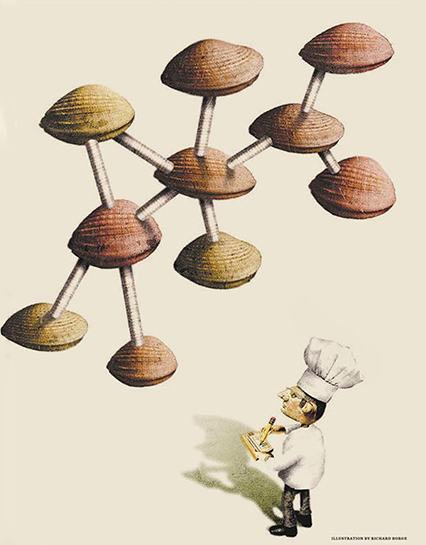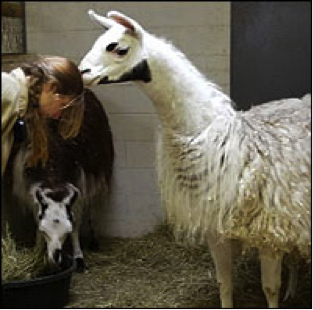Shell Game:
It's full steam ahead for a food chemist who helped bring clam chowder to Middle America.
Does the best New England clam chowder actually come from Maryland's Eastern Shore?
Sounds like heresy, but more than a few fans of prepared chowder think it's true. For that they can thank RobertBredimus, a 63-year-old food chemist who began taming clams for Middle American tastes more than three decades ago.
"There are good clam notes and bad clam notes," Bredimus explains. "The bad ones are amines - that's what's fishy -and sulfide, which is rotten-eggy. There also can be iodine and iron tastes. Yet copper you need in shellfish because it's nice, the briny marine type flavor; so it's a balance."
That's how a food chemist talks. Part scientist and part artist, the food chemist is playing an increasingly important role in commercial food production, often working beside famous chefs to turn great individual recipes into great recipes for thousands, or millions.
Bredimus is director of research and development for Seafood Watch International, a family-owned, Easton-based seafood firm that over the years has quietly become a top producer of chowder and other processed clam products - primarily for the restaurant and supermarket trade.
Over the years, he says, he's developed 260 varieties of clam chowder, three of which were on display at the Boston Seafood Show last winter. The New Englanders dropped by in droves for samplings.
Like most of his colleagues, Bredimus is virtually unknown outside the industry. And so is the work that food chemists do.
"A food chemist understands the chemistry of each ingredient and how they interact," explains Herbert Stone, president of the Washington-based Institute of Food Technologists. "It's the only field of chemistry where taste, texture and color are as important as density, boiling point and other standard properties learned in chemistry class."
Bredimus, who grew up in New Jersey and says he tasted his first clam at a restaurant in Hoboken, studied chemical engineering at what is now the New Jersey Institute of Technology but dropped out to start working in the food industry.
He worked a variety of jobs over the years including, he said, a stint with a firm that helped develop feeding techniques for NASA's astronauts.
Along the way, Bredimus says, he learned the art and science of food chemistry. He worked with renowned chefs Jacques Pepin, Pierre Franey and Jean Jacques Paimblanc at a time when a relationship between food chemist and chef was rare.
"I was born with really good taste buds, and they respected me for that," says Bredimus, who credits his father, a gifted amateur chef who lived many years in France.
Bredimus says his own big break came in 1970, when Howard Johnson's hired him to join the French chefs on a mission: to introduce land-locked Americans to clam chowder.
"They would make these exquisite soups and chowders," says Bredimus. "We would taste them and talk about them. I would then figure out how to make a 500-gallon kettle of one to taste like that."
Overall, Bredimus figured, clam chowder contained the elements that most regions of the country respond to - the creaminess of a milk-based chowder combined with the sweetness of clams.
Still, to appeal to palates 1,500 miles from the nearest clam bed, something also needed to be done about the clam's very clam-iness. What was too mild for a New Englander - or a coaster from the Great Lakes or Oregon - wasn't mild and sweet enough for an Iowan or Nebraskan.
"I didn't strive for the pinnacle, the ultimate possible taste experience," Bredimus said, but one "high on the slope."
Paimblanc, HoJo's research director at the time and later executive chef for Legal Seafood restaurants, describedBredimus as the man who got things working.
"Bob, he'd never claim to be a chef but is a very good scientist. And he had a knack to make things happen," Paimblanc says.
The efforts of Howard Johnson's and others eventually helped make New England clam chowder one of the three most popular soups in America. That's no small feat considering an industry estimate that less than 5 percent of Americans relish the raw taste of the prime ingredient.
Taming the flavor of the bivalve is only part of the battle for better chowder. Bredimus experiments with mixing juices from clam beds that are as much as 400 miles apart.
One day, Bredimus might correct a deficiency in one batch by mixing in quahog juice and clam viscera. Or figure out how to increase the calcium taste-note by adding liquid from the shucking of clams. Soup solids need balancing to be evenly distributed between servings.
"All to get the type of chowder you would get at home," he says.
Yet Bredimus' methods horrify New England seafood purists, because putting clam chowder in a can isn't the same as making it by the beach.
Old salts trace their clam chowder to that served in the mythical Try Pots - the "fishiest of all fishy places" described by Ishmael in Herman Melville's Moby-Dick. It was at this Nantucket inn that one ate clam and fish chowder "till you began to look for fishbones coming through your clothes."
Bredimus' ultimate quest is for the best amino acids, specifically glutamic acid, aspartic acid, glycine, serine and proline. "Those are the ones that contribute to the best-tasting clam chowder," he declares.
"That's an oxymoron. It's never going to be as good as an ordinary family's clam chowder," says Dave Masch as he steams clams on his stove in Cataumet, Cape Cod. Masch is a seafood columnist for On the Water magazine and author of the coming cookbook Cooking the Catch.
He has spent 29 years cooking on a wood stove and can go weeks without a meal that doesn't have a clam in it.
"One thing you don't want to do to any seafood," he says, "is to make it taste less than what it is. There's no great mystery to making clam chowder. Its simplicity is one of its strong points. By making it complex, you might as well be making Tang instead of orange juice."
The point, says Bredimus, "isn't to make it better. It's to make it repeatable."
And so on. Bredimus does have to worry about issues, such as consistency, that the home cook doesn't encounter.
"When I have to get 20 million pounds of clams a year, for reasons of health I need to clean the clam up so it's safe, but then I need to add back some flavor notes," he says.
For example, he says, "We take algae out of the clam's gut when we remove it, or we may have a little of the algae in the clam juice. ... You're taking something great and mass producing it and then trying to bring it back to its natural state."
Although Bredimus' knowledge comes from experience, most food chemists today are formally trained.
"It's a must to have a food science degree," says chef John DeShetler, a professor at the Culinary Institute of America. "Years ago, everything could be self-taught. Today they need to work within a research and development kitchen. They need that degree to know what's happening, even if they're cooking for a magazine or doing recipe work for a book."
Likewise food science students are nudged toward internships with chefs. Unlike Bredimus' route - his undergraduate course work was in chemical engineering - many students now enter food science programs with formal cooking training.
Y. Martin Lo, an associate professor of food and bioprocess engineering at the University of Maryland's College of Agriculture and Natural Resources, estimates that one-third of the program's 32 undergraduate students have studied culinary arts or arrange internships with ingredient companies, where they work with chefs.
"It's very new," says Lo, who coordinates internships. "We're seeing more and more interaction between the two groups."
Most major food companies employ chefs who have restaurant or service business experience, says Stone. "One thinks in terms of ingredients and preservation and safety, proper handling; the other is concerned with how they are going to put the ingredients on a plate."
Or in Bredimus' case, a bowl. "I'm not making clam chowder different," he says. "I'm exploring the limits of how good it can be."


